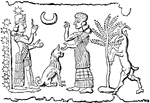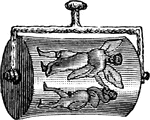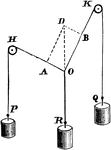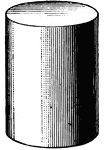
Cylinder
A cylinder is a body of uniform diameter throughout its entire length, whose ends are equal parallel…

8-Cylinder car
In the season of 1915 the 8-cylinder car proved an absorbing topic for automobile engineers and experts,…

Coulomb’s torsion balance
Coulomb's torsion balance is in the shape of a cylinder with the pan inside.
Smooth Caterpillar
The body is cylinder and divided by rings into thirteen segments. The smooth caterpillars don't have…

Hairy Caterpillar
Caterpillars are an insect that is cylinder and is divided by rings into 13 segments. The hairy caterpillar…

Spanner Caterpillar
Caterpillars are insects that are cylinder and are divided by rings into 13 segments. The spanner caterpillar…

77th Pennsylvania Regiment
"Captain Muller's Battery Company of the Seventy-seventh Pennsylvania Regiment making fascines and gabions…
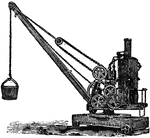
Steam Crane
"A Crane is a machine for lifting weights, worked either by hand or by steam, or by hydraulic power.…
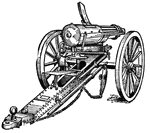
Gatling Gun
"The Gatling gun is a machine gun, invented by Richard J. Gatling. The gun consists of a series of barrels…
Portion of a medullated nerve fiber
"The axis cylinder is in the center. On either side is seen the medullary sheath, represented by dark…
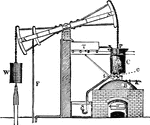
Steam Engine
"Newcomen's Atmospheric Steam-Engine. A, A, working-beam; B, boiler from which steam is admitted through…

Phonograph
"A Phonograph is an instrument for recording and reproducing sounds, invented by Thomas A. Edison."—(Charles…

Chain Pump
"A Pump is a machine, engine, or device, consisting of an arrangement of a piston, cylinder, and valves,…
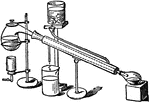
Retort
"A Retort is a vessel in whose chamber an object is subjected to distillation or decomposition by heat,…
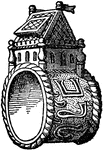
Ring
"A Ring is any circle or section of a cylinder. Rings of gold, silver, and of other metals and materials…

Ring
"A Ring is any circle or section of a cylinder. Rings of gold, silver, and of other metals and materials…
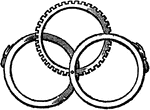
Ring
"A Ring is any circle or section of a cylinder. Rings of gold, silver, and of other metals and materials…
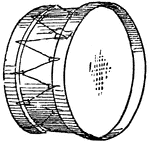
Drum
An instrument of music, consisting of a hollow cylinder, upon which a piece of vellum is stretched,…
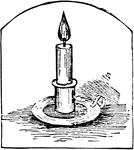
Candle
A cylinder of tallow, wax, spermaceti, paraffine, or other combustible substance, inclosing a wick,…

Cannon
A large hollow metal cylinder closed at one end, and variously mounted, used for throwing balls by the…
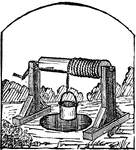
Windlass
A cylinder or roller for raising weights, turned by a crank or lever, with a rope or chain attached…

Cylinder
A body of roller-like form, of which the longitudinal section is oblong, and the cross-section is circular.

Hand-organ
A portable organ played by means of a cylinder set with pins and staples, and turned with a crank.

Safety-lamp
A lamp surrounded with a cylinder of wire gauze, to give light in mines, without the danger of setting…
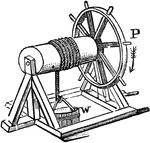
Wheel and axle
"The wheel and axle consists of a wheel united to a cylinder in such a way that they may turn together…
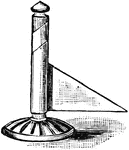
Diagram of a screw
"That the screw is a modified inclined plane, may be shown by winding a triangular piece of paper around…

Lift pump
"The lift pump or suction-pump consists of a cylinder or barrel, piston, two valves, and a suction pipe,…

Force pump
"The operation of the force-pump is similar to that of the suction-pump. The outlet-valve generally…

Fire syringe
"Place a bit of tinder in the cavity of the piston of the 'fire-syringe'. Put the piston into the open…
Siemens armature
"Consists of a coil of wire wound in two broad grooves plowed on opposite sides of an iron cylinder."…
Drum armature
"The drum armature differs from the shuttle armature chiefly in that it employs many coils instead of…

Hydrometer
Nicholson's Hydrometer, consists of a hollow cylinder of metal with conical ends, terminated above by…

Hydrometer
Nicholson's Hydrometer, consists of a hollow cylinder of metal with conical ends, terminated above by…

Air Pump
This air pump contains a glass or metal cylinder called the barrel, in which a piston works. The piston…

Revolver
A firearm resembling a pistol, but differing from it in having a breech-loading cylinder so arranged…
Mercury Tube
This illustration shows the proportions of volume in which hydrogen and oxygen combine by introducing…

Right Cylinder
a solid which may be concieved as generated by the revolution of a rectangle about one of its sides.

Ignition System
Diagram of a low-tension ignition system. A is the battery, B is a spark coil, and C, D, and E are the…

High-Tension Ignition System
Diagram of a high-tension ignition system. A is the source of current, usually a batter in earlier days,…

Dixie 4-Cylinder Magneto
End elevation and section of Dixie 4-Cylinder Magneto showing construction and connections.

Delco Installation
Delco starting and lighting installation on the Pathfinder, 1917 Twelve-Cylinder Model.

Nerves
"a, axis cylinder; b, inner border of white substance; c, c, outer border of same; d, d, tubular membrane;…

Wheel and Axle
"The wheel and axle consists of two cylinders of different diameters, rigidly connected, so that they…

Danglish Apparatus
"The Danglish apparatus consists of the following parts: 1st, a generator A, in which carbonic acid…

Blowing-Machine
"An American machine, introduced into England by Mr. Ellis. It consists of an iron cylindrical casing…

Coal-cutting Machine
"This machine consists essentially of a horizontal piston and cylinder engine fixed upon a platform…
